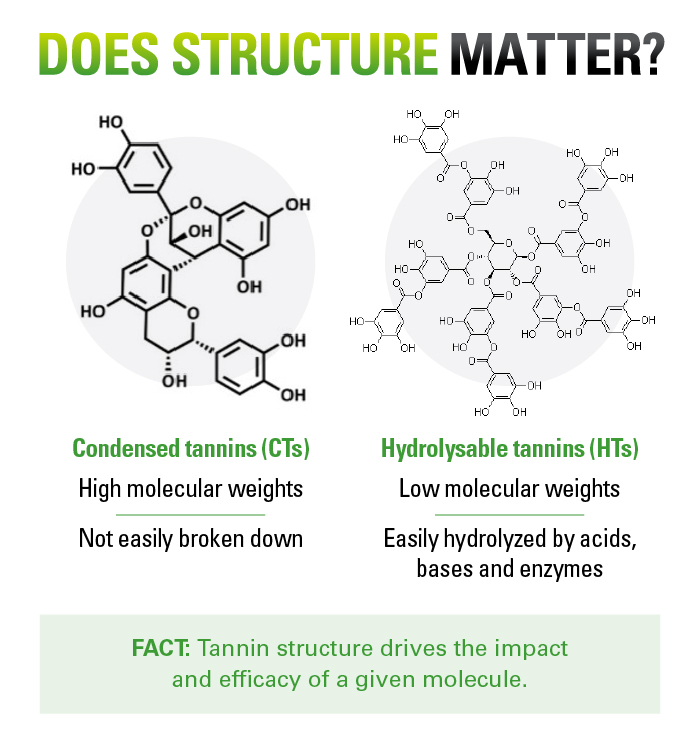Myth #4 – Tannins are Unhealthy for Poultry
Fact: Dietary tannins – when dosed correctly – offer a wide-range of benefits that support optimal gut health and performance of poultry. First, tannins are potent natural antioxidants as well as anti-inflammatory molecules. Second, tannins are astringent, meaning they may help to tighten junctions between intestinal epithelial cells, thereby helping to prevent leaky gut syndrome. Third, tannins have been shown to positively modulate the intestinal microbiota composition and may help to maintain mucosal immunity.2,8 Fourth, tannins offer antimicrobial activities by inhibiting growth of several poultry pathogens such as Campylobacter spp.2, Salmonella spp.2 and Clostridium perfringens.3,9

Summary
Despite their historical connotation as anti-nutritive factors, tannin-based feed ingredients can offer poultry producers new solutions to include in their gut health toolbox. Importantly, producers must remember that using tannins in poultry diets is a balancing act. Choosing the right tannin, at the right level and at the right time is crucial to ensure the benefits of tannin-based feed additives are realized.
As a phytogenic and probiotic combination, VANNIX™ C4 serves as a multi-mode of action gut health solution to help minimize the effects of coccidiosis infection as well as reduce the opportunity for secondary bacterial challenges in poultry. Its tannic acid extract (TAE) – a unique hydrolysable tannin – has been shown to inhibit growth of coccidia parasites and reduce intestinal lesions,10 thereby improving intestinal integrity to support optimal performance of poultry.
For more information on how VANNIX™ C4 can support poultry intestinal health, visit kemin.com/vannixc4.
References
1Mueller-Harvey, I. (2006). Unravelling the conundrum of tannins in animal nutrition and health. J. Sci. Food Agric., 86:2010-2037.
2Redondo, L. M. et al. 2014. Perspectives in the use of tannins as alternative to antimicrobial growth promoter factors in poultry. Frontiers Microbiol. March(5). doi:10.3389/fmicb.2014.00118.
3Hassan, Z. M. et al. 2020. The effects of tannins in monogastric animals with special reference to alternative feed ingredients. Molecules. 25:4680; doi:10.3390/molecules25204680.
4Chung, K. T., et al. 1998. Are tannins a double-edged sword in biology and health? Trends in Food Sci. Tech. 9:168-175.
5Elizondo, A. M. et al. 2010. Effect of tannins on the in vitro growth of Clostridium perfringens. Vet. Microbio. 145:308-314.
6Chung, K. T., et al. 1998. Mechanism of inhibition of tannic acid and related compounds on the growth of intestinal bacteria. Food and Chem. Tox. 36:1053-1060.
7Min, B. R. and S. P. Hart. 2003. Tannins for suppression of internal parasites. J. Anim. Sci. 81(E. Suppl. 2):E102-E109.
8Carrasco, J.M.D. et al. (2018). Tannins and bacitracin differentially modulate gut microbiota of broiler chickens. BioMed Research International, https://doi.org/10.1155/2018/1879168.
9Tosi, G. et al. (2013). Efficacy test of a hydrolysable tannin extract against necrotic enteritis in challenged broiler chickens. Italian Journal of Animal Science, 12:3, DOI: 10.4081/ijas.2013.e62.
10Tonda, R.M. et al. (2018). Effects of tannic acid extract on performance and intestinal health of broiler chickens following coccidiosis vaccination and/or a mixed-species Eimeria challenge. Poult. Sci., 97:3031-3042.





